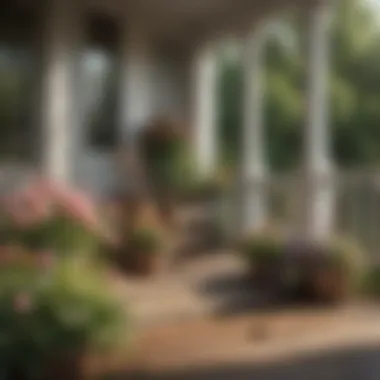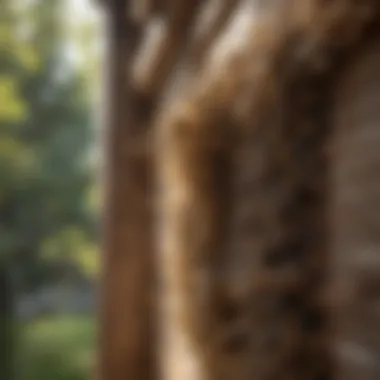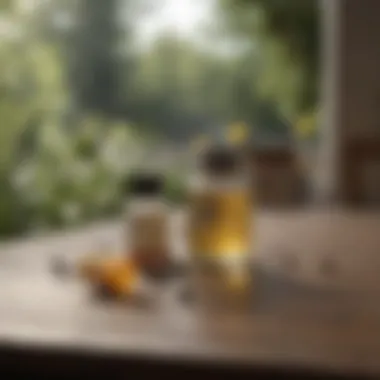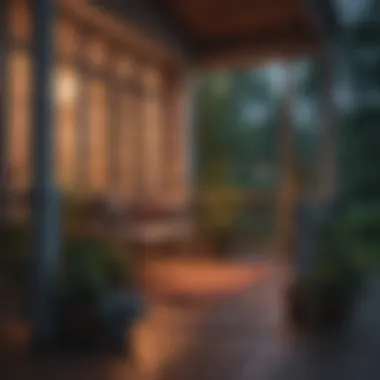Strategies for Managing Bees and Wasps on Your Porch


Intro
Dealing with bees and wasps on your porch can be quite the challenge for any homeowner. These buzzing insects often transform a relaxing outdoor setting into a nerve-wracking experience. Yet, rather than resorting to drastic measures, gaining an understanding of these creatures and their behavior can really make a difference. This guide offers effective strategies to not only manage but also peacefully coexist with bees and wasps, ensuring your porch remains a welcoming space.
From identifying the specific species making themselves at home to utilizing humane removal practices, this resource is packed with actionable steps. In the following sections, you’ll uncover the smart design ideas that discourage these critters while also making your outdoor area visually pleasing. Let's dive into how you can address this common issue with elegance and confidence.
Preamble to the Challenge of Bees and Wasps
Sharing your porch with bees and wasps is a common dilemma for many homeowners. This issue, although seemingly minor, can impact outdoor enjoyment and even safety. Understanding the behavior of these insects and recognizing how they interact with our surroundings is crucial for developing effective strategies for management. After all, we want our outdoor spaces to be relaxing rather than nerve-wracking.
Bees and wasps play vital roles in ecosystems, particularly in pollination. Yet, their presence can often lead to unwanted encounters. It's essential to appreciate this delicate balance when discussing how best to address their presence on porches. Failing to recognize the unique traits of these insects may lead to ineffective or harmful control measures.
Understanding the Distinction Between Bees and Wasps
While bees and wasps share some similarities, knowing the differences is essential. Bees tend to be plump, covered in hair, and are generally focused on collecting pollen and nectar. Their primary aim revolves around foraging and supporting plant life. Wasps, on the other hand, usually have smoother bodies and are more slender. Some, such as yellow jackets, can become aggressive, especially if they feel threatened.
Understanding these distinctions guides management techniques. For instance, if you're dealing with honeybees, approaches should be more gentle or even involve safeguarding their colonies, while tougher strategies might be needed for wasps. Ultimately, the key is recognizing the specific insect you’re contending with.
Why They Are Attracted to Your Porch
Bees and wasps, despite their pesky reputation, are not aimlessly buzzing around. Their attraction to your porch stems from various inviting factors. Here are a few that commonly draw them in:
- Food Sources: Leftover food from outdoor dining can be a significant draw. Even tiny crumbs can pique their interest.
- Scented Candles and Fragrances: Many scented products mimic the smells of flowers, another significant attraction. Even sweet-smelling soaps or perfumes can lure them unaware.
- Waste Containers: If garbage bags or bins are left uncovered, these sights can signal a banquet for these insects.
Understanding what attracts these creatures to your space equips you with the knowledge to deter them effectively. Tidying up different elements on your porch and maintaining cleanliness can vastly reduce unwanted visits, making your outdoor experience much more comfortable.
Assessing the Severity of the Problem
Understanding how to assess the presence of bees and wasps on your porch is crucial. This step allows homeowners to gauge the extent of the issue, identify specific trouble spots, and take informed action. By evaluating the severity of a bee or wasp infestation, you can prioritize your removal strategies and determine whether they can be managed at home or if professional help is needed. An early assessment can prevent a simple nuisance from escalating into a more serious problem.
Identifying Infestations and Their Locations
To tackle bees or wasps effectively, the first step is spotting them. Look around your porch and nearby areas for signs of infestations. These can include:
- Nests: Usually hidden under eaves, in wall voids or sheds. The size and location of a nest can tell you whether it’s a minor issue or something that could spiral out of control.
- Frequent Activity: Take note of how many bees or wasps are buzzing about and where they seem to be coming from or going to, as this can lead you directly to their source.
- Distinct Behaviors: Observing how they behave can also give clues. For example, if you notice wasps hanging around your food or drink when you're outside, it points to their attraction to vacancies rather than nesting habits.
Once you have a clear indication of infestation scale, you can determine whether the situation warrants immediate action.
Understanding Seasonal Behaviors
Bees and wasps, much like clockwork, exhibit distinct seasonal patterns that can shape your strategies for prevention and management. Their behavior changes with the weather and the seasons, particularly in regions with marked seasonal variations. Here's a breakdown of what you might observe:
- Spring: This is when queens come out of hibernation, looking for suitable spots to establish nests. They often look for warm areas near human habitats, so it’s vital to check your porch during this crucial period.
- Summer: Activity peaks in the summer as colonies reach their maximum size. This is the time to be extra cautious as wasps may become more aggressive, especially if they feel their nest is threatened.
- Autumn: As temperatures drop and food sources dwindle, bees and wasps often become more desperate and may venture closer to human gatherings, particularly around outdoor events.
- Winter: Many bees hibernate while wasps die off, leaving only queens to overwinter. Cleaning up your porch and ensuring it's less attractive to returning bees and wasps is wise during this downtime.
Understanding these seasonal behaviors means you can anticipate potential problems and take proactive steps to mitigate the risk of infestation, allowing for a more enjoyable outdoor experience.
"A stitch in time saves nine; detecting and managing pests early can save considerable trouble later on."
Identifying infestations and being aware of seasonal behaviors will not only inform your action plan but also enhance your overall environment.
Preventative Measures to Deter Bees and Wasps


Taking steps to prevent bees and wasps from settling around your porch is crucial for creating a welcoming outdoor space. Not only does prevention minimize the risk of potential stings, but it also promotes harmony between humans and these essential insects. The strategies outlined below focus on reducing attractants and employing natural deterrents, which not only offer a solution but also respect the role these creatures play in our ecosystem.
Eliminating Attractants Around Your Porch
Food Sources
Food sources significantly draw bees and wasps to your porch, creating an increased likelihood of unwanted visitors. These pests are particularly enticed by sugary substances, so keeping snacks, drinks, or even bird feeders well away from your outdoor seating areas is essential.
One key characteristic of managing food sources is the emphasis on cleanliness. Regularly cleaning up spills and crumbs is not just a chore; it’s an effective strategy in keeping these pests at bay. Additionally, tightly sealing trash cans prevents the delicious smells from wafting into the air, which can attract bees and wasps from a distance.
Unique features of the food sources themselves can have both advantages and disadvantages. While it may be tempting to serve sweet treats outdoors during a gathering, it’s wise to consider how quickly they can attract the attention of nearby bees and wasps.
Scented Candles and Fragrances
Scented candles and various fragrances can also lure these insects to your porch. Candles infused with sweet scents, especially floral or fruity ones, can make your outdoor space smell delightful. However, these same fragrances may turn your porch into a beacon for bees and wasps.
The primary challenge with scented products is their appeal not just to humans but to insects as well. This makes them a double-edged sword. While they are popular for enhancing ambiance, they necessitate careful consideration regarding safety. Opting for unscented candles or choosing scents that bees and wasps tend to avoid can maintain enjoyment of your space while minimizing the risk of unwanted guests.
Utilizing Natural Repellents
Essential Oils
Natural repellents, particularly essential oils, present an effective way to deter bees and wasps without harming them. Certain oils like peppermint, eucalyptus, and citronella are known for their pest-repelling qualities. Not only do they smell good to us, but these scents are quite off-putting to many bees and wasps.
A significant benefit of using essential oils is their natural origin; they avoid the harmful chemicals found in many commercial insecticides. This makes them a popular and safe choice for those who want to keep their outdoor spaces pleasant without risking damage to the environment.
The unique feature of essential oils is their versatility. You can use them in diffusers, as part of homemade sprays, or even in soaks for your outdoor furniture. However, it's important to remember that the efficacy may vary, necessitating reapplication after rain or prolonged exposure to sunlight.
Herbs
Herbs are another natural option to keep bees and wasps at bay. Plants like basil, mint, and lavender are not only beautiful but effective as deterrents. Their strong scents tend to repel these insects, which can lead to a more enjoyable outdoor experience.
The key characteristic of herbs is their dual purpose; they enhance your garden's aesthetics and can be used in your kitchen as well. This practicality makes them a beneficial choice for readers who are keen on gardening or cooking.
However, one must be cautious when choosing herbs as some may attract other beneficial insects. Careful planning and strategic placement in your garden or around your porch are important to strike the right balance.
"An ounce of prevention is worth a pound of cure."
Safe Removal Techniques
Dealing with bees and wasps in your outdoor spaces can be quite the headache. Understanding safe removal techniques is essential not just for the comfort of your porch but also for the well-being of these important insects. Removing them safely ensures that you minimize harm—both to yourself and the bees and wasps. The goal here is to find a balance that protects your space while respecting these creatures’ roles in the ecosystem.
Homemade Traps and Deterrents
Creating homemade traps can be an effective way to manage the presence of bees and wasps without resorting to harmful chemicals. One popular method is to use a simple bottle trap that attracts these insects.
- Materials Needed: You just need a plastic bottle, sugar, water, and a bit of vinegar.
- Instructions: Cut the bottle in half, mix the sugar water with a splash of vinegar, and place the top half upside down in the bottom half to create a funnel.
- Placement: Set these traps near known problem areas, like under porch eaves or around outdoor dining spaces.
The beauty of homemade traps lies in their simplicity and cost-effectiveness. They can help reduce the number of insects without risking the general local bee and wasp populations. Just remember to check them regularly and dispose of any caught insects properly to keep your area clean and hygienic.
When to Call Professionals


There may come a time when the issue with bees and wasps escalates beyond what can be managed with simple techniques. Recognizing the right moment to call in professionals is crucial.
Identifying Dangerous Nests
Knowing how to identify dangerous nests is key to determining whether professional assistance is necessary.
- Key Characteristics: A dangerous nest may appear larger than usual, often housing more aggressive species like yellow jackets or bald-faced hornets. Look for nests that are built in hidden places—inside walls, under eaves, or even in trees. If the nest seems to pose a direct threat to your family members or pets, it’s time to take action.
- Why It’s Beneficial: Calling a professional not only ensures safety but also takes the guesswork out of managing the situation.
- Unique Features: A pro will have access to specialized equipment and methods for removing nests safely. They will often assess the situation and decide whether relocation or extermination is more appropriate, keeping your safety front and center.
Choosing Certified Exterminators
It's essential to choose certified exterminators when the time comes to bring in professional help to ensure safe and effective addressing of the issue.
- Key Characteristic: Certified exterminators are trained and experienced in dealing with various types of infestations. They know the right methods to employ for specific species and can manage the removal process with minimal risk.
- Why It’s Popular: Homeowners often feel a sense of relief when professionals handle challenging situations, knowing they can rely on expert knowledge and tools tailored for the job.
- Unique Features: These professionals can offer solutions that not only focus on immediate removal but also include long-term strategies to prevent recurrence. The downside is cost, but the investment often pays off in peace of mind and safety for you and your family.
Overall, adopting safe removal techniques allows you to navigate the tricky waters of having bees and wasps present on your porch. Whether relying on homemade traps or deciding when to call in professional help, you’ll have the tools to ensure both safety and respect for these vital pollinators.
Enhancing Porch Design for Bee and Wasp Management
When it comes to managing the presence of bees and wasps on your porch, diving into porch design may not be the first thought that pops into your mind. Yet, it plays a crucial role in how these insects interact with your outdoor space. An effectively designed porch can dramatically reduce the likelihood of bee and wasp infestations while allowing you to enjoy nature without feeling on edge.
Incorporating Bee-Friendly Plants Strategically
Planting choices are vital in creating a welcoming yet controlled environment for your porch. Select plants that attract bees while being mindful of wasps’ preferences. For instance, herbs like lavender, rosemary, and mint can be delightful additions. These not only bring beauty and fragrance; they also provide food sources for bees. However, go easy on plants like flowering fruit trees or aromatic meats, as they may also attract wasps.
Position these plants away from your seating area. This way, you can enjoy their benefits without inviting bees too close for comfort. Use pots or planters to keep everything neat and manageable. This creates a buffer zone, allowing bees to pollinate without causing disturbances to your gatherings.
Here are a few tips for incorporating plants effectively:
- Consider bloom time: Ensure you have a variety of blooming plants throughout the season to keep bee activity in check.
- Group similar plants: This helps bees forage efficiently.
- Choose native plants: They are often better suited for local fauna, making them easier to maintain.
Design Elements to Minimize Nesting Opportunities
Aesthetic taste aside, design aspects of your porch can actively deter wasps from setting up shop. First off, aim for smooth and clean surfaces. Wasps are drawn to rough, dark, and concealed areas where they can build nests. Opt for materials that are hard to make nests on, such as metal or smooth woods.
Moreover, eliminate any nooks that can serve as potential nesting sites. Under eaves or railing posts are places where wasps might think they found their new home. Using a simple sealant to close these openings can work wonders.
Incorporate design features that promote visibility and light near your porch, as wasps prefer shaded and hidden spaces. Brighter areas are less inviting. Adding trimmed hedges or a transparency feature like glass walls can further create an unfriendly nesting environment.
"Design is not just what it looks like and feels like. Design is how it works."
This principle rings true for porch management. Implementing these strategic design elements makes your porch less appealing for wasps while enhancing your outdoor experience.
The holistic approach to designing your porch not only protects you from irritation but also fosters an inviting atmosphere for bees and other pollinators, creating a delicate balance between nature and human activity. Think about durability and maintenance as well; you wouldn’t want a rotting wooden deck inviting critters into your space. With these considerations in mind, your porch can serve as a thriving yet controlled outdoor oasis.
Understanding the Ecological Importance of Bees and Wasps
When addressing the presence of bees and wasps on your porch, it's crucial to look beyond mere nuisance. Understanding their ecological roles can redefine our perspective, allowing for a more harmonious coexistence. Bees and wasps do not only contribute to biodiversity; they play essential roles in agriculture and nature. By assessing their importance, we can better appreciate their presence and adopt strategies that align with both human comfort and ecological health.
The Role of Bees and Wasps in Pollination
Pollination is one of the most significant contributions of bees and wasps to the ecosystem. Bees, particularly honeybees and bumblebees, are often spotlighted in this role, but numerous wasp species contribute too, albeit in less obvious ways.


- Bees transport pollen from flower to flower, ensuring the reproduction of many plants, which, in turn, provides food and habitat to various species. It’s estimated that approximately one in three bites of food we eat is thanks to insect pollinators, primarily bees.
- Wasps, on the other hand, also play a part in pollination, albeit mostly as incidental pollinators while searching for food sources. They are attracted to flowering plants like goldenrod and asters, helping to facilitate fertilization in these plants as they dart about.
Understanding this relationship highlights the necessity for bees and wasps in maintaining healthy ecosystems. Their role in pollination directly correlates to the productivity of our gardens, farms, and wild landscapes.
Benefits of Coexisting with Pollinators
The presence of pollinators around your home can yield numerous benefits, both directly and indirectly. It may seem counterintuitive to welcome these insects given their potential to annoy.
- Enhanced Garden Productivity: Homes with flourishing bee and wasp populations often see improved yields from flowers, fruits, and vegetables. A modest vegetable patch, for instance, can bear witness to a thriving bee community, resulting in lush tomatoes and zucchini.
- Biodiversity Support: Encouraging these creatures can improve the overall biodiversity of your garden. Varied species can flourish, leading to a more resilient ecosystem.
- Natural Pest Control: Wasps, particularly, are predators of many garden pests, such as aphids and caterpillars. Their presence can reduce the need for chemical pesticides, promoting a healthier environment.
"A garden absent of pollinators may yield less produce and suffer health issues, essentially reverting to a less vibrant ecosystem."
Ultimately, understanding the ecological importance of bees and wasps reshapes the narrative. They are not just pests; they are vital components of a functional ecosystem. By learning how to manage their presence on our porches, we can strike a balance that allows for both human enjoyment and ecological preservation.
Long-term Management Strategies
Addressing the presence of bees and wasps on your porch is not merely about quick fixes. Long-term management strategies are crucial for creating a safe outdoor environment, ensuring that you can enjoy your space without constant worry about these pollinators. It involves a blend of preventive measures and positive practices that harmonize your living space with the ecosystem.
The benefits of implementing long-term strategies include not just immediate comfort but also fostering a sustainable relationship with nature. Instead of the constant battle against stinging insects, you can transform your porch into a welcoming habitat, which supports local wildlife while ensuring safety for family and friends.
Creating a Bee and Wasp-Friendly Environment
To truly manage your porch effectively, consider designing it in a way that allows for both human enjoyment and bee and wasp coexistence. For starters, you might want to start with native plants. These plants are easier for local bee species to access, promoting population health. Some ideal options include lavender, sunflowers, and cone flowers. These beauties not only add aesthetic appeal but also support the local bee community.
Incorporate features such as bee hotels—these are simple structures that provide shelter for solitary bee species. You can create them using hollow stems or wood blocks with drilled holes. Placing a bee hotel in an inconspicuous area can help provide bees with nesting options away from your main activities.
Another effective strategy is to implement water sources that cater to these creatures. A shallow dish filled with pebbles and water provides the sustenance they require while minimizing any nuisance. That way, they don't mistake your porch for their favorite hangout and can buzz off happily elsewhere.
Community Efforts to Ensure Safe Outdoor Spaces
What’s better than tackling this issue alone? Teaming up with neighbors! Community efforts are a powerful way to create a harmonious living environment for all. Organize neighborhood workshops where residents can discuss and share their own strategies for dealing with bees and wasps.
You can set up community gardens that not only beautify your area but create a collective habitat for pollinators. Such communal spaces can serve as a beacon, attracting bees and wasps without drawing them to individual porches. Sharing resources like native plants or DIY bee hotels can also foster collaboration among homeowners.
Additionally, raising awareness and educating your community on the importance of pollinators can change perceptions positively. Hosting local events, such as Meet the Pollinators days, can help demystify these insects while highlighting their ecological significance.
"Creating a community of understanding around bees and wasps can lead to more sustainable, peaceful outdoor environments for everyone."
The goal is not just to keep these pollinators at bay but to ensure that they can thrive while keeping you safe. By embracing a collective approach, you strengthen the local ecosystem and can enjoy your porches without constant concern.
End and Final Thoughts
Addressing the presence of bees and wasps on your porch is not merely an act of pest control; it’s about creating a welcoming, safe environment for yourself and your guests. As you’ve gathered from this article, these insects play vital roles in our ecosystem, particularly in pollination. Thus, while managing their presence is important, it should be approached thoughtfully.
Successful implementation of the strategies detailed here fosters a balanced relationship with nature. From understanding their behaviors to employing effective removal techniques, each step aids in maintaining a safe outdoor space.
Summarizing Key Takeaways
- Distinction Matters: Knowing the difference between bees and wasps helps in understanding their behavior and how to manage them.
- Infestations: It’s critical to assess and identify nesting locations for both safety and control efforts.
- Prevention First: Eliminating attractants and utilizing natural deterrents can greatly reduce unwanted visits.
- Design Strategically: Incorporating features that deter nesting ensures long-term comfort on your porch.
- Community Counts: Engage with neighbors to create a unified front against infestations and promote a healthy ecosystem.
Encouraging Responsible Management Practices
It cannot be overstressed how essential is the approach to managing bees and wasps responsibly. This involves considering humane techniques and preserving the natural order.
- Educate Yourself and Others: Share your knowledge about the ecological roles of bees and wasps among friends and neighbors.
- Be Proactive: Refusing to wait for a problem to arise can save time and further complications later. Cleverly designed outdoor spaces can act out as safe havens for both you and beneficial insects.
- Stay Informed: Regularly update your strategies by staying knowledgeable about insects in your area, especially as seasons change.
Ultimately, fostering a collaborative approach to managing bees and wasps can create an outdoor ambiance that is enjoyable, safe, and ecologically friendly. By incorporating effective strategies from this guide, homeowners can not only secure their porches but also contribute to the well-being of our buzzing allies.















